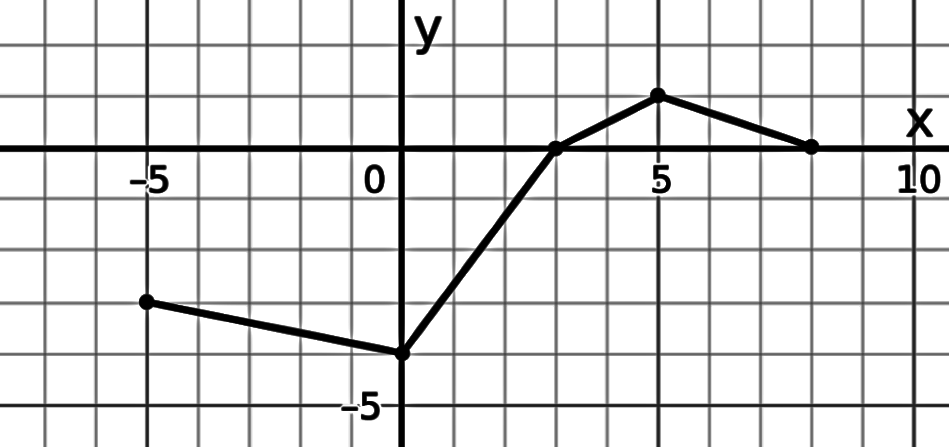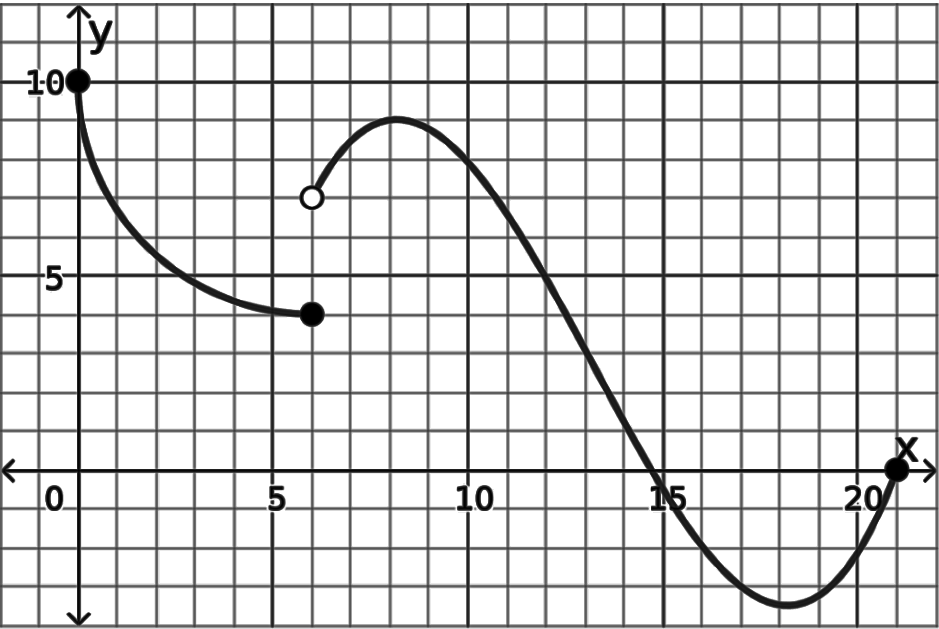
What are the coordinates of the y-intercept?
(0, -4)
a(x) = 4x + 6, b(x) = 2x + 3
c(x) = a(x) + b(x)
c(x) = ?
c(x) = 6x + 9
Given the function d(t) = 10t...
If t = 5, we have d(5). What does d(5) equal?
d(5) = 10(5)
d(5) = 50

If x = 3, f(3) =
0

What are the coordinates of an x-intercept? Double points for naming BOTH x-intercepts.
(3, 0) and (8, 0)

What are the coordinates of a minimum? Double points for getting BOTH minimums.
(0, -4) and (8, 0)
d(x) = 5x + 8, e(x) = 3x - 4
f(x) = d(x) + e(x)
f(x) = ?
f(x) = 8x + 4
Given the function d(t) = 10t...
If d(t) = 80, what does t equal?
80 = 10t
t = 8

If f(x) = 1, then x =
5

What are the coordinates of a maximum? Double points for getting BOTH maximums.
(-5, -3) and (5, 1)

What is the domain of the graph (the set of all the x-values, set inside [brackets])?
[-5, 8]
a(x) = 9x + 4, b(x) = -6x + 3
c(x) = a(x) + b(x)
c(x) = ?
c(x) = 3x + 7
The distance that a dog can run in feet is measured based on how many seconds he has been running. This distance can be modeled by the function d(t) = 10t, where d(t) is the distance in feet at time t in seconds.
How far has the dog run in 3 seconds?
30 feet
3 seconds means t = 3

If x = -5, f(-5) =
-3

What is the range of the graph (the set of all the y-values, set inside [brackets])?
[-5, 1]

What is the interval of increase? Put the x value at the start of the interval and the x value at the end of the interval inside brackets like [X1, X2].
[0, 5]
d(x) = -8x - 6, e(x) = 3x + 14
f(x) = d(x) + e(x)
f(x) = ?
f(x) = -5x + 8
The distance that a dog can run in feet is measured based on how many seconds he has been running. This distance can be modeled by the function d(t) = 10t, where d(t) is the distance in feet at time t in seconds.
If the dog has run 60 feet, how long has the dog been running?
6 seconds
60 feet means d(t) = 60

If f(x) = -4, x =
0

What is an interval of decrease? Put the x value at the start of the interval and the x value at the end of the interval inside brackets like [X1, X2]. Double points for getting BOTH intervals of decrease.
[-5, 0] and [5, 8]

What is the domain of the graph (the set of all the x-values, set inside [brackets])?
[0, 21]
The Flash and Quicksilver are trying to see how many steps they take while running around in a blizzard. The function that models the number of steps the Flash takes each second is f(t) = 12t + 50. The function that models the number of steps Quicksilver takes is q(t) = 15t + 120. Find the function s(t) that represents the number of steps that both take put together; s(t) = f(t) + q(t).
s(t) = 27t + 170
The distance that a dog can run in feet is measured based on how many seconds he has been running. This distance can be modeled by the function d(t) = 10t, where d(t) is the distance in feet at time t in seconds.
How long has the dog been running if d(t) = 255?
25.5 seconds
d(t) = 255, 255 = 10t. Divide both sides by 10.

If x = 4, f(4) =
0.5 or 1/2

What is the range of the graph (the set of all the y-values, set inside [brackets])?
[-3.5, 10]